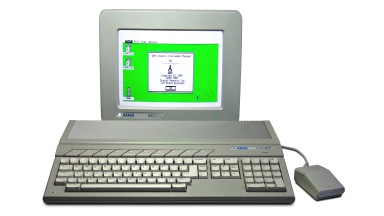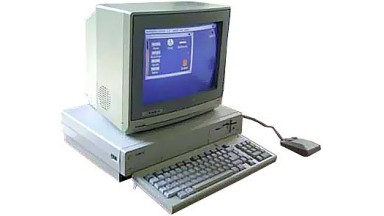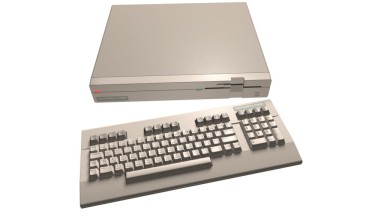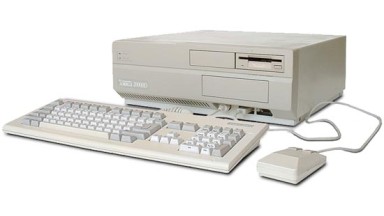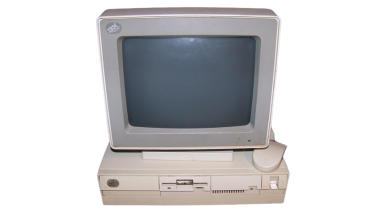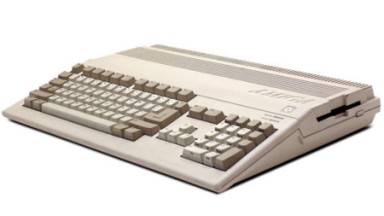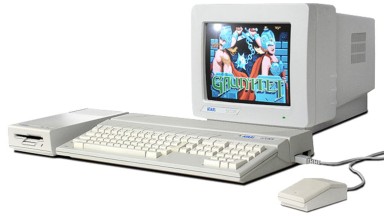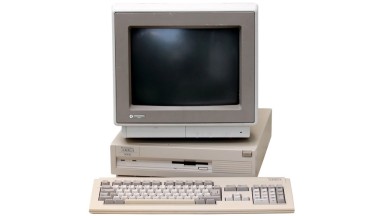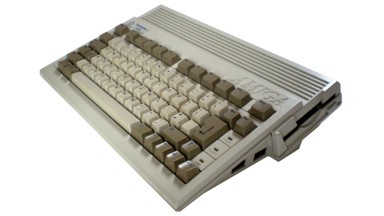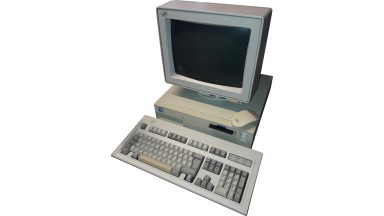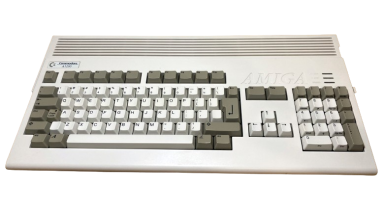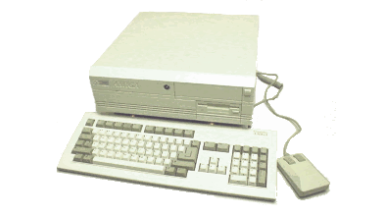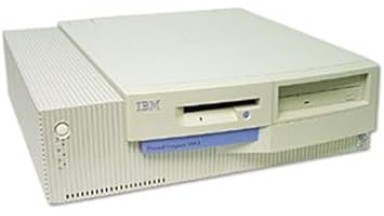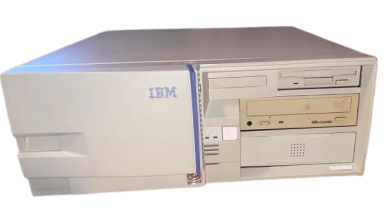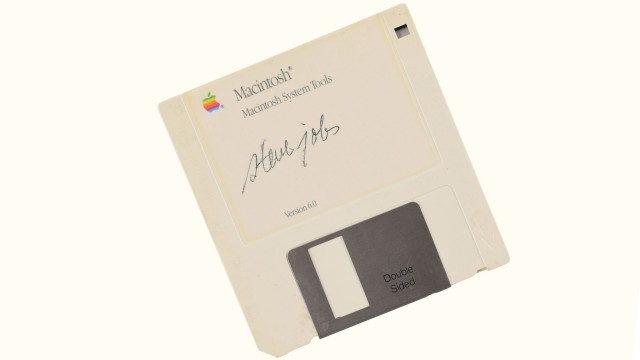
Diskette 3½" DD
Company: Sony
Launched: 1984
Capacity: 720 KiB
In 1984, Apple incorporated this format for its new Macintosh computers.
In 1985, Atari adopted it for its new ST line, and Commodore for its new Amiga.
Personal computers equipped width Diskette 3½" DD
Manufacturer: Atari
Launches: 1985
CPU:
Motorola 68000
@ 8MHz
Memory: 512 KB ~ 4 MB
Support: Diskette 3½" DD
Hard drive:
Operating system: TOS
Innovations: It was the first computer to include a color graphical interface (Digital Research's GEM), and its high resolution in monochrome mode made it ideal for desktop publishing and CAD.
It also included a MIDI interface, making it a common device in music studios.
It was also the first series of personal computers to include up to one megabyte of RAM from the factory.
The ST family (which stands for Sixteen/Thirty-two, referring to the internal and external bus of the Motorola 68000 processor it included) is the successor to the Atari 8-bit family.
It rivaled the Commodore Amiga and the Apple Macintosh, for which it was a cheaper alternative.
It included the 260, 520, 1040, and Mega models, which were released between 1985 and 1991.
Manufacturer: Commodore
Launches: 1985
Manufactured in US
CPU:
Motorola 68000
@ 7.09MHz
Memory: 256 KB ~ 8 MB
Support: Diskette 3½" DD
Hard drive:
None
Operating system: AmigaOS 1.0
The Amiga 1000 was Commodore's first multimedia personal computer model.
Created by Jay Miner, who also created the Atari 800 years earlier, when he was already working at his company, he took out a loan from Atari to develop the new model, which he couldn't repay. Commodore then acquired Amiga Corp. and paid off the loan.
Manufacturer: Commodore
Launches: 1987
Manufactured in US
CPU:
MOS Tecnology 8502
@ 2MHz
Memory: 128 KB
Support: Diskette 3½" DD
Hard drive:
None
Operating system: BASIC
Very similar in appearance to the 128D, it was a low-cost model thanks to its more compact design.
It was sold primarily in the United States and Canada starting in 1987.
Manufacturer: Commodore
Launches: 1987
Manufactured in US
CPU:
Motorola 68000
@ 7.09MHz
Memory: 1 MB ~ 9 MB
Support: Diskette 3½" DD
Hard drive:
None
Operating system: AmigaOS 1.2
Despite being aimed at the high-end market, it was technically very similar to the Amiga 500.
The Amiga 2500 model was a variant with two pre-installed floppy drives, sold in the United Kingdom.
Manufacturer: IBM
Launches: 1987
Manufactured in US
CPU:
Intel 80286
@ 10MHz
Memory: 1 MB ~ 7 MB
Support: Diskette 3½" DD
Hard drive:
20 MB
Operating system: PC DOS 3.3
Manufacturer: Commodore
Launches: 1987
CPU:
Motorola 68000
@ 7.14MHz
Memory: 512 KB
Support: Diskette 3½" DD
Hard drive:
None
Operating system: AmigaOS 1.2
This low-cost Commodore, aimed at the home market, was a huge success in Europe, where it dominated the computer video game market, rivaling the Sega Megadrive and Super Nintendo video game consoles.
Manufacturer: Atari
Launches: 1989
CPU:
Motorola 68000
Memory: 512 KB ~ 4 MB
Support: Diskette 3½" DD
Hard drive:
None
Operating system: TOS 1.06
In late 1989, Atari Corporation released the 520STE and 1040STE, an improved version of the ST with improvements in multimedia hardware and the operating system.
Manufacturer: Commodore
Launches: 1990
Manufactured in US
CPU:
Motorola 68030
@ 16MHz
Memory: 2 MB ~ 18 MB
Support: Diskette 3½" DD
Support B: Diskette 3½" DD
Hard drive:
None
Operating system: AmigaOS 1.4
It was a professional multimedia computer, successor to the Amiga 2000.
Manufacturer: Commodore
Launches: 1992
CPU:
Motorola 68000
@ 7.14MHz
Memory: 1 MB
Support: Diskette 3½" DD
Hard drive:
None
Operating system: AmigaOS 2.05
It was the last computer in the Amiga family based on the Motorola 68000 and the 1990 Amiga Enhanced chipset.
It was smaller than the Amiga 500 because it lacked the numeric keypad. It also added the option of an internal hard drive and a PCMCIA port.
Manufacturer: IBM
Launches: 1992
Manufactured in US
CPU:
80386SX
@ 20MHz
Memory: 2 MB
Support: Diskette 3½" DD
Hard drive:
40 MB
Operating system: PC DOS
Manufacturer: Commodore
Launches: 1992
Manufactured in US
CPU:
Motorola 68EC020
@ 14.32MHz
Memory: 2 MB
Support: Diskette 3½" DD
Hard drive:
None
Operating system: AmigaOS 3.0
This computer was supposed to be the replacement for the successful Amiga 500, but by the time it was released, the PC compatibles already offered similar graphics and sound features at a similar price.
Manufacturer: Commodore
Launches: 1992
Manufactured in US
CPU:
Motorola 68040
@ 25MHz
Memory: 2 MB ~ 18 MB
Support: Diskette 3½" DD
Support B: Diskette 3½" DD
Hard drive:
None
Operating system: AmigaOS 3.0
It was the most powerful of the Amiga family.
The tower box version was called the Amiga 4000T.
Manufacturer: IBM
Launches: 1997
Manufactured in US
CPU:
Intel Pentium
Memory: 16 MB ~ 128 MB
Support: Diskette 3½" DD
Support B: CD
Hard drive:
2147483647 MB
Operating system: Windows 95
The PC 300GL series used Celeron, Pentium I, Pentium II, and Pentium III processors throughout its lifespan. Celeron-based models had processors clocked at 333, 366, 433, 466, 500, or 533 MHz; Pentium I models had processors clocked at 133 or 166 MHz; Pentium II-based models had processors clocked at 350, 400, and 450 MHz; and Pentium III-based models had processors with clock speeds of 450, 500, 533, 550, 600, 667, 733, 800, or 866 MHz.
These systems came in two case types: desktop and microtower.
There were two variants of the desktop case, one with two expansion slots and the other with four. Both variants had four drive bays.
The microtower case had four expansion slots and four drive bays.
Manufacturer: IBM
Launches: 1997
Manufactured in US
CPU:
Intel Pentium
Memory: None
Support: Diskette 3½" DD
Support B: CD
Hard drive:
Operating system: Windows
The PC 300XL computer uses the Pentium MMX clocked at 233 MHz or the Pentium II clocked at 233, 266, or 300 MHz.
And it featured built-in 10/100 Ethernet.
